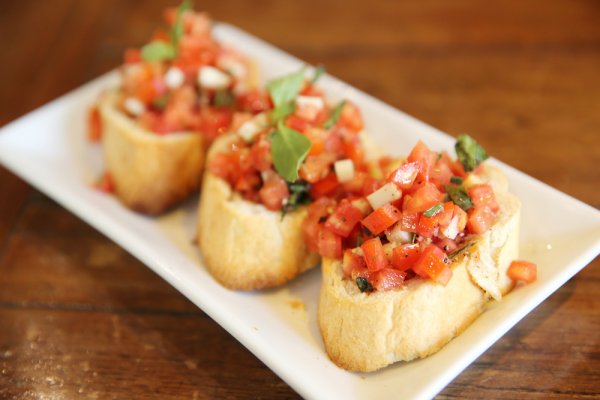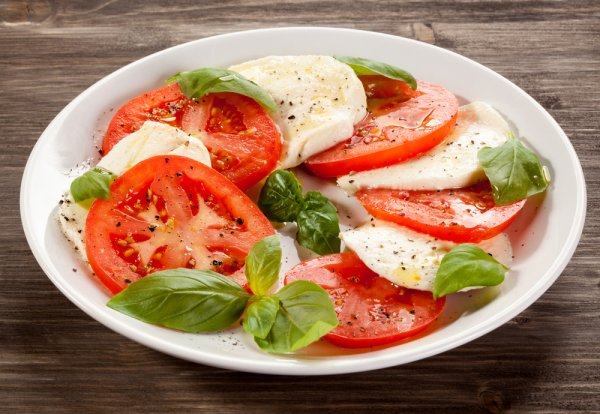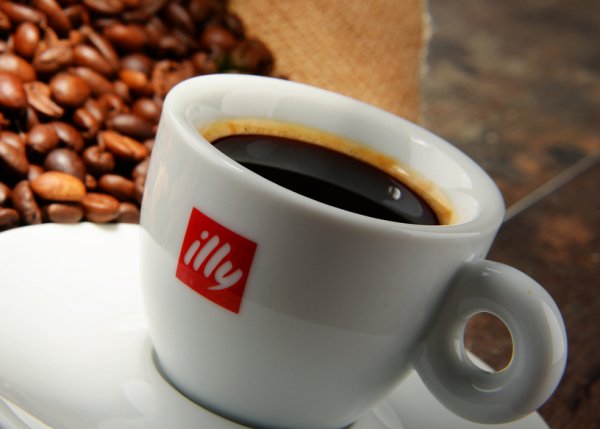Food and Drink: Classic Dishes
Listed below are a few of the many dishes associated with the cuisine of Italy. Recipes for these classic dishes and many others can be found in the Recipes section.
APPETIZERS
Bagna Cauda – A hot anchovy dip made with olive oil and garlic.
Bruschetta – Toast with a topping is a popular appetizer commonly served with pre-dinner drinks. Bruschetta may be simply toasted bread rubbed with garlic, olive oil, and herbs, or it may have many ingredients. The most common version of the dish is topped with a simple fresh tomato salad.
Focaccia – A flat bread cooked with rosemary and olive oil, sometimes served with prosciutto. Usually served as an appetizer.
Fonduta – Common in the Valle d’Aosta, where Alpine weather makes rich foods a necessity, and also in Piedmont, fonduta is the Italian version of Swiss fondue, made primarily from Fontina cheese melted with milk and bound with egg yolk. The dish is traditionally flavored with a little white truffle, though this ingredient is often omitted because of its expense.
Frito Misto – Literally "mixed fry," frito misto normally includes veal, chicken, and vegetables such as cauliflower or artichoke, all deep fried and served with lemon.
Prosciutto e Melone – An extremely simple appetizer, this dish is simply slices of ripe melon wrapped with thin slices of prosciutto, an uncooked, dry-cured ham. Although this dish originated in Emilia-Romagna where prosciutto di Parma is produced, it is now common throughout Italy when melons are in season and is widely considered a classic combination.
SOUPS
Minestrone – An Italian soup with many regional variations, minestrone usually includes pasta, beans, and vegetables. It is usually a thinner, more vegetable-rich soup than pasta e fagioli and is likely to contain small quantities of seasonal greens such as chicory or escarole.
Pasta e Fagioli – Pasta and bean stew, flavored with bacon, vegetables, and herbs, is a classic everyday Italian dish, especially in cold weather.
Stracciatella – A simple soup from Rome, stracciatella is a rich chicken broth with a mixture of egg, Parmesan, and semolina or breadcrumbs drizzled in. The soup is usually flavored with a little nutmeg and parsley.
Zuppa di Pesce – Fish dishes, particularly fish stews and soups, are common through most of the country, given Italy’s long coastline. Most include an assortment of fish and seafood, wine, tomatoes, herbs, and perhaps a few vegetables, and are designed to use the catch of the day with commonly available ingredients. Cioppino, burrida, brodetto, and cacciucco are all regional names for fish soups.
SALADS
Insalata Caprese – A simple salad from the Italian region of Campania, made of fresh mozzarella and tomatoes seasoned with basil, salt, pepper, and olive oil.
Insalata di Arance – Orange salad is a Sicilian specialty. At its simplest, it is sliced oranges with salt and olive oil, but cooks often add onions, black olives, and black pepper.
Insalata di Carciofi – Artichokes, trimmed, blanched, and dressed with olive oil, lemon, Parmesan, salt, and pepper, are a popular seasonal salad in most of Italy.
MAIN DISHES
Abbacchio al Forno – Young roast lamb baked with olive oil, wine, garlic, and rosemary is a classic Roman springtime dish.
Bucatini all'Amatriciana – Amatriciana is a regional variation on the tomato-based sauce popularly served with pasta. It is flavored with smoked pork and onion and is traditionally served over bucatini, a fat, hollow spaghetti.
Lasagne – The word lasagne refers to wide, flat sheets of pasta and also to the dish made from this ingredient: a baked pasta casserole layered with sauces, usually a milk-based béchamel and a red, tomato-based sauce, and sometimes with meat, vegetables, or cheese. Each region, and in fact many sub-regions, have their own versions of lasagne made with local products or specialty cheeses or sauces.
Pesce Spada Caponata – A Sicilian specialty, swordfish with an eggplant and tomato caponata sauce is a typical southern Italian dish.
Pizza Margherita – Although it probably originated in Naples, pizza, olive-oil based bread dough rolled thin and baked with a variety of toppings, is now common throughout Italy. Pizza Margherita, made with tomato slices or sauce, mozzarella cheese, basil, and perhaps a sprinkle of Parmesan, is the classic pizza, but a wide variety of cheeses, vegetables, and meats are now common on Italian pizzas.
Saltimbocca alla Romana – This classic dish consists of thin slices of veal topped with a slice of prosciutto ham and a sage leaf, pan-fried and served with a sauce made by deglazing the pan with white wine or Marsala. Occasionally, the veal is rolled around the ham and secured with a toothpick or skewer before frying. Saltimbocca means "jumps in the mouth."
SIDE DISHES
Polenta – Polenta, coarse cornmeal simmered to a soft porridge, is a common side dish throughout northern Italy. It can be served as soon as it is made or it can be cooled and cut into slices to be baked or sautéed. Covered with sauce, it is a tasty comfort food.
Risotto alla Milanese – Risotto alla Milanese, a saffron-flavored rice dish also called risotto giallo or risotto allo zafferano is a classic side dish with osso bucco, braised veal shank.
Spinaci alla Romana – Spinach sautéed with raisins, pine nuts, and garlic is a classic way of serving hot greens, especially in the central and southern parts of the country.
DESSERTS
Cannoli – Cannoli are tubular Sicilian pastries, thin rounds of dough shaped on a metal form, deep fried, cooled, and filled with a rich ricotta-based cream.
Coffee Gelato – The Italian version of ice cream, gelato is normally made with whole milk rather than cream and is frozen to a softer consistency than most ice creams. Although it is probably a Northern invention, gelato is now common throughout Italy. Vanilla, chocolate, hazelnut, pistachio, and seasonal fruit flavors are all classic, and more inventive flavors are becoming common. This particular gelato recipe combines two national specialties into one quintessentially Italian dessert.
Panna Cotta – This cold dessert made with heavy cream, sugar, gelatin, and vanilla hails from the Piedmont region of Italy.
Zabaglione – An egg custard made by heating and beating egg yolks, sugar, and Marsala or other wine, zabaglione is a common dessert throughout Italy. It can be made with white wine or sparkling wine and is sometimes flavored with liqueur. Less strongly flavored versions of the dessert are sometimes served with fresh fruit.
BEVERAGES
Bitters – Bitter alcoholic drinks served before and after meals to help the digestive process are popular in Italy. Campari, for example, is a typical aperitif usually served diluted with sparkling water, while Averna, various brands of Amaro, and Fernet Branca are all common after-dinner drinks. All are infused with different herbs for flavor.
Coffee – In Italy, coffee means espresso, a rich, slightly thick coffee served in very small portions. Espresso is combined with hot milk to make caffe latte, a typical morning beverage, or with smaller quantities of steamed milk to make cappuccino, usually consumed in the afternoon with a sweet snack. Coffee is consumed throughout the day: for breakfast, when socializing, and after meals.
Wine – Italy produces a wide variety of wines, including red, white, sparkling, and dessert wines. Wines are regularly served with meals and are commonly chosen to complement the menu as much as possible.
HOLIDAY FAVORITES
Panettone – An Italian Christmas bread commonly made with eggs, yeast, dried fruit, nuts, and sometimes liqueur.
Copyright © 1993—2025 World Trade Press. All rights reserved.

 Italy
Italy 







